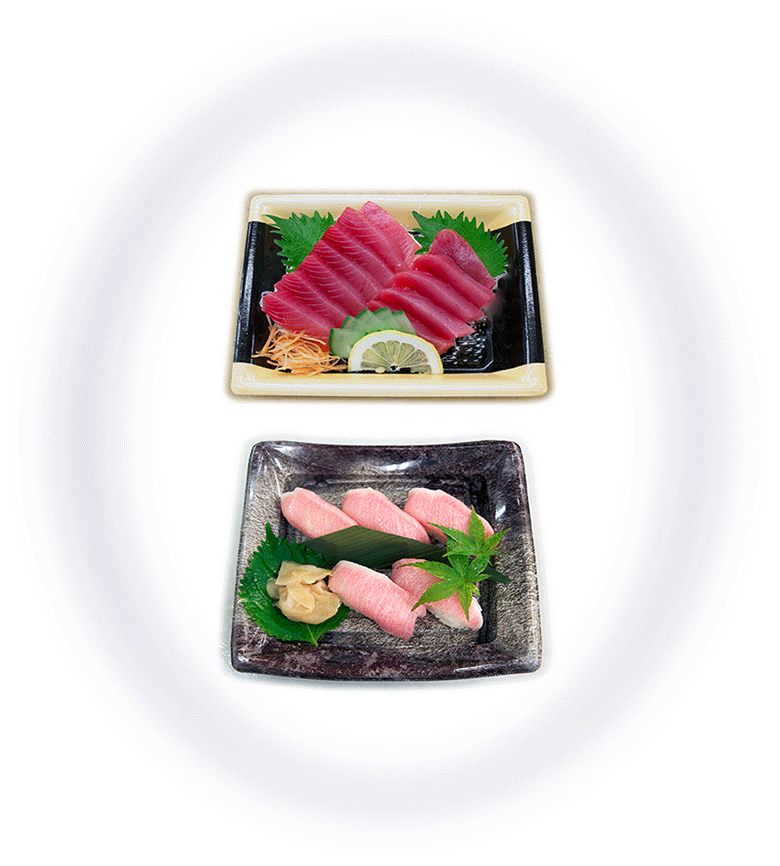| Please access the following URL if you want to secure using SSL. All pages in the site will be secure pages. |
| https://secure02.blue.shared-server.net/www.fish-food.co.jp/message english 4.2019.html |
Welcome to FISH FOOD TIMES
Apr. 2019 issue No.184

�@ �@
�@
It is troubled with the handling of small bluefin tuna ...
From the old days at the fish market located near a fishing port where natural bluefin tuna is often landed, it has been frequently heard from the fishery related people who deliver fish that small bluefin tuna are troubled to enter the fixed net too much.
The Japanese yokowa is a juvenile bluefin tuna shown in the image below, also known as meji, which is less than 30 kg in size.
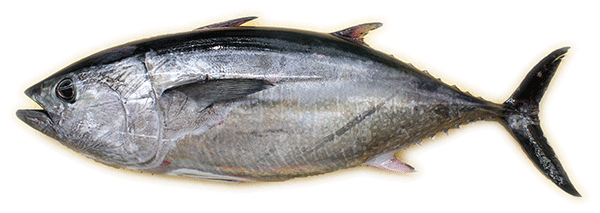
It is impossible to ignore that this small bluefin tuna is often in the net, and it should not be something that fishermen would say by nature, but this is a reality that is afflicting fishermen in the field.
In Hokkaido last year, one incident involving small bluefin tuna occurred. The catchment of Hokkaido by coastal fishery such as in a fixed net of Pacific bluefin tuna small fish (less than 30 kg) was allocated 57.3 tons in the period from July 2017 to June 2018. However, in the Minamikayabe district of Hakodate, there was a large catch of 356 tons of small bluefin tuna for 5 days from September 28 to October 2, and the cumulative total of landing until that time became 540 tons, which is 10 times the catch limit, the limit has been greatly exceeded.Since it exceeded the upper limit of the total quantity in the 20 prefectures co-managing the fishing net of the fixed net, the Fisheries Agency has a situation of requesting the self-restraint including the prefectures other than Hokkaido, it also had a major impact on coastal fishing.
The Fisheries Agency set a quota for small bluefin tuna 4,007 tons and large bluefin tuna 4,882 tons as a voluntary initiative from January 2015 at the WCPFC: Western and Central Pacific Fisheries Commission meeting in December 2014, and more bluefin tuna Declared no fishing. However, since a large excess of small bluefin tuna catches occurred in Hokkaido, as a measure not to repeat such a thing, offshore fishery is from January, 2030 and coastal fishery is from July, 2030 It was decided to move to a possible volume of TAC.
However, the fact that small bluefin tuna can be caught as much as 356 tons in only 5 days in a fixed net in Hokkaido may be something more or less similar in other areas of Japan, and it can not be said from now on It is thought that.
Habitat situation and catch condition of bluefin tuna
For example, according to the Fisheries Agency's announcement, there is a habitat condition of bluefin tuna as shown in the following figure, and it is acknowledged that bluefin tuna resources near Japan are steadily increasing.
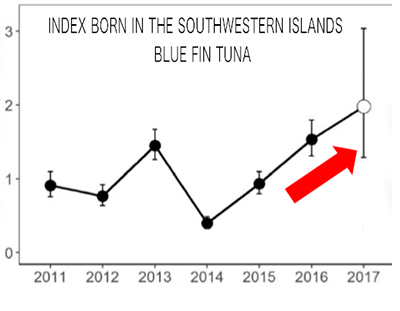
In the above table, there is an indication of "index of birth in the Nansei Islands", but the meaning can be understood if you look at the following illustration, which is the publication material of the Fisheries Agency.
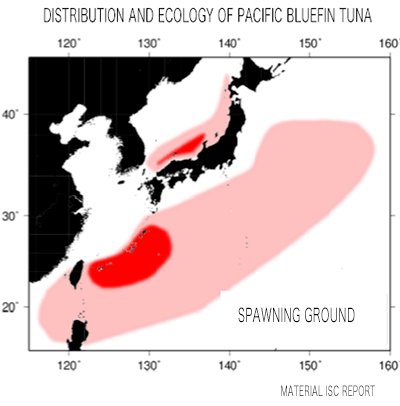
According to the International Scientific Committee for Tuna and Tuna-like Species in the North Pacific Ocean's "Results of stock assessment of Pacific bluefin tuna", the parent fish stock in 2016 is estimated to be approximately 21,000 tons, which are It has been recovering slowly since becoming the lowest in 2010.
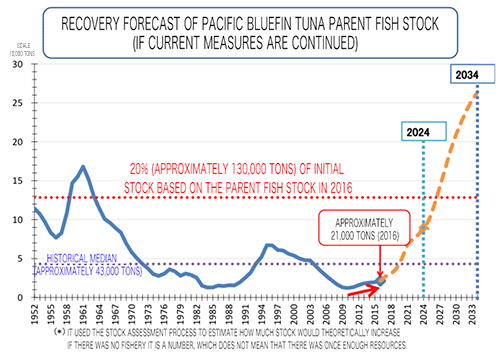
Japan maintains and manages bluefin tuna based on the evaluation of ISC: North Pacific International Tuna Subcommittee under the WCPFC: Midwestern Pacific Tuna Commission. According to the data released by the Fisheries Agency on December 27, last year, as stated in the above graph, the basic policy of the bluefin tuna preservation and management plan is 60% of the current It is said that there is a goal to restore the volume to the historical median value of 43,000 tons.
And it was decided that the next 5th management period (offshore fishery one year from January, 2013, coastal fishery one year from April, 2010) becomes the catch shown in the following table.
| Type 1 Specified Marine Biological Resources | Period to be managed | Catchable amount |
|---|---|---|
| Bluefin tuna | 5th management period | 8,889tons |
| Small size | 5th management period | 3,757tons |
| Large size | 5th management period | 5,132tons |
Conflict between the reality of the fishery and the national response
Japan set a quota for small bluefin tuna 4,007 ton and large blue tuna 4,882 ton as a voluntary initiative from January 2015 at the WCPFC: Midwest Pacific Tuna Commission international conference in December 2014. As stated above, the above bluefin tuna was declared not to be caught.
However, the bluefin tuna resources bottomed in 2010 and have been increasing each year, and the Fisheries Agency announced that the bluefin tuna born in the South West Islands in 2017 is four times the level compared with 2014, the total catch amount for the fifth management period of this year will remain unchanged at 8,889 tons, the same as when the catch limit was started voluntarily.
Although bluefin tuna stocks are increasing, what does it mean that the amount of catch does not increase?
In this case, especially in the fixed net fishery where fishermen can not choose the type of fish that enters the net, it is possible that something similar to what happened in the Hokkaido Minamikayabe area will occur in other areas from now on. For such a situation, the Fisheries Agency recommends that only bluefin tuna be released from the fixed net, and as a concrete method, bluefin tuna is devised by the operation method, fishing method (fishing gear / net), release method, equipment introduction, etc. They are instructed to make sure that their fish catch does not increase.
However, such instructional content is easy to say from the standpoint of a national great person, but it must be very troublesome on fishing boats. I got into a ship with a fixed net and had me show me where to pull up the net. Even if I am not a fisherman, I can imagine that it is not such an easy task to escape only bluefin tuna from the net containing various fish in a mixed state. Where is the cause of having to impose on the fisherman the way of suffering which must not exist as a fishery?
There is one thing that can be considered. It seems that it is probably because I can not feel persuasive about the sentences in the graph shown above.
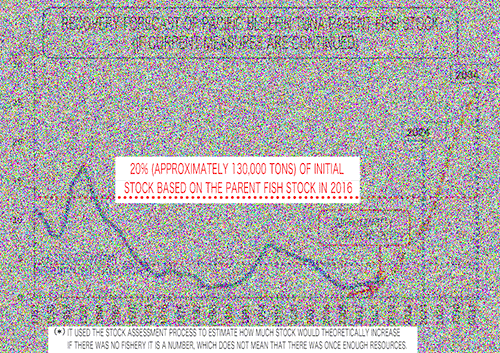
I have highlighted some of the graphs shown earlier, so let's take a closer look.At the bottom is a small letter that explains "the amount of initial resources". And there is written as follows. This is a figure that estimates how much resources will theoretically increase if there is no fishery by using stock assessment processes. It does not mean that there was once enough resources. In other words, it is declared here that this is simply a desktop inferred number, and it is different from the fact based on the field.
Also, in the red text in the middle, it seems that 20% of the initial amount of resources is targeted at 130,000 tons. This "20% of initial stock amount" figure is derived from MSY theory (Maximum Sustainable Yield), which is thought that maximum catch can be obtained each year by maintaining one resource at a certain level.
When is initial resource amount initial? I would like you to make it clear at least as early as when it is ancient or modern. However, the MSY theory using this initial resource term is just an assumption, and it is surprising because it has never been demonstrated.
Errors of MSY theory so far and new environmental change theory
About this unproven MSY theory, Professor Kazumi Sakuramoto of Tokyo University of Marine Science and Technology,among fisheries promotion 605th, “To solve the resource management problem of tunas (A new resource change to replace MSY theory - ) describes the problem logically.And, based on this MSY theory, it is the members of the WCPFC: Western and Central Pacific Fisheries Commission that are giving the figures of the bluefin tuna catch total regulation that currently disrupts the Japanese fishery industry.
According to Professor Kazumi Sakuramoto, resource researchers at WCPFC argue that "the main factor in determining resource change is density." However, the professor says that "the main cause of resource change is not density but environmental change." And it is concluded that the idea of MSY theory based on the density effect that "the reproduction relationship between the bluefin tuna parent and child is unknown" is false.
In the illustration below, Professor Sakuramoto states that resource change occurs as two processes, a and b, are alternately repeated.
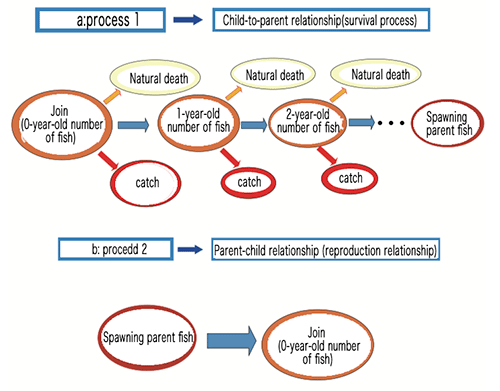
The process 1 in Figure a above shows that Pacific bluefin tuna catches more than 65% of the number of fish caught at all ages within the age of 0 and is always eaten by other fish or by humans It is exposed to the threat of being caught. This is the process of survival until the mature age where egg laying can be performed, and this is called the "survival process".
And process 2 of b shows the "reproduction relationship" of the circulation that a child becomes a parent, a parent gives birth and a child becomes a parent and gives birth. The idea that emphasizes the density effect of MSY theory is said to be "determined by the density of spawning parent fish" in this process 2. However, Professor Sakuramoto's resource change theory says that process 2 is "determined largely by the effects of environmental change."
It is difficult for the author to explain in an easy-to-understand manner the contents of the academic paper written by Professor Sakuramoto. If you want the reader to find out more about it, please visit https://doi.org/10.423/oalib.1104341 to read and understand it yourself. I will not explain the contents of the paper in detail, but II will not explain the contents of the paper in detail, but I would like to take up only the points below. The interesting thing is that Professor Sakuramoto has written a red arrow in the dissertation, saying, "Please skip to read this far."
I would like to follow the professor's advice, read almost all the red arrows, and summarize and explain only the points. The text after this is a summary of Professor Sakuramoto's ideas, and it is not a theory that I have conceived, but I would like you to forgive for the convenience of explanation that it is expressed as if it were my opinion.
First of all, as a comparative example, 62 years of recruitment amount and spawning parent fish quantity of Pacific group sardines are shown in the graph, so let's start from this.
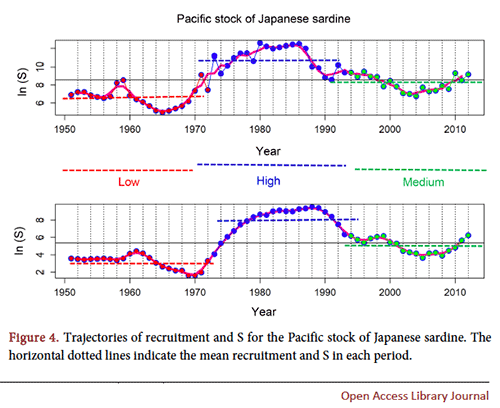
If you replace the upper line graph with a scatter diagram (XY graph), a clockwise loop is drawn as shown below.
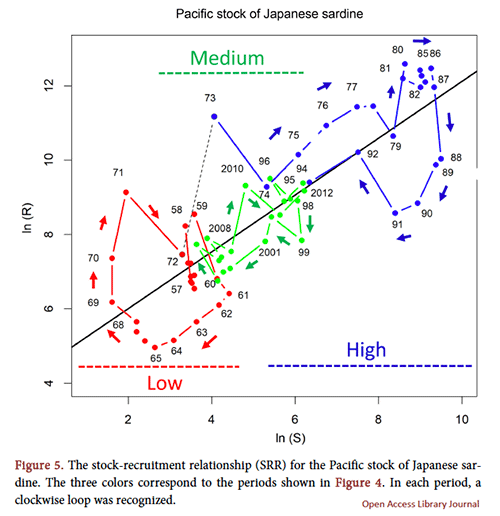
And then, if you chart the 61 year aging change and reproduction relationship of Pacific bluefin tuna recruitment amount and parent fish quantity in the same way, it becomes as follows.
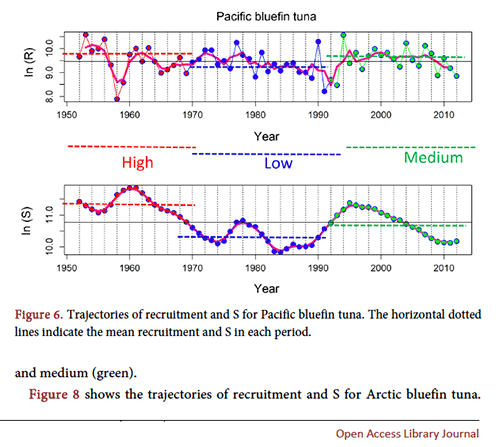
Then, replacing the upper line graph in the same way in the scatter diagram (XY graph), a counterclockwise loop as shown below is drawn.
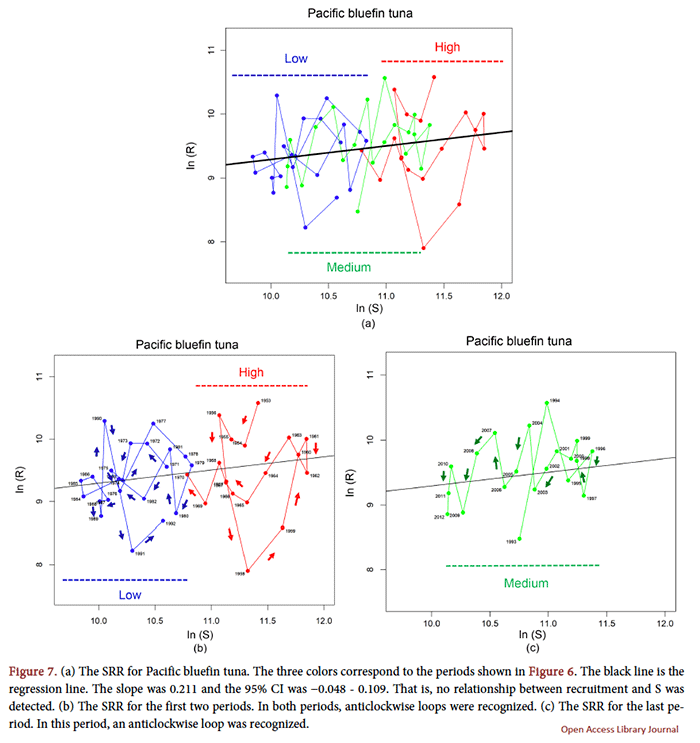
The reproduction relation obtained by simulation has eight patterns. I would like to explain "sardine corresponds to b in Fig. 8 and blue fin tuna corresponds to c in Fig. 8" described in the lower sentence of sardine and the scatter diagram of blue fin tuna above. I would like to add that it is the following pattern in it.
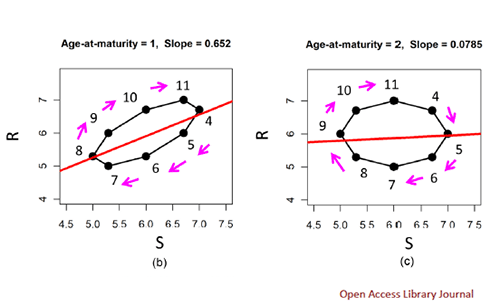
If this sardine and bluefin tuna diagram (XY graph) is simplified and illustrated, three periods (low level period, high level period, middle level period) become patterns like dumpling on a skewer as follows: . And the difference is that the sardine's skewering dumpling has a tilt, and the bluefin tuna skewering dumpling has no tilt.

Because the skewer dumpling of sardines has a large tendency to increase and decrease the spawning parent fish size, the dumplings are skewed in different forms without overlapping. In the case of bluefin tuna, although there are three similar dumplings, the trend of increase and decrease is not as great as that of sardines, so the difference is that the dumplings are stacked and spread horizontally. The bluefin tuna has the feature that the reproduction relationship is hard to be recognized clearly like a sardine.
From these simulation results, it can be derived that "the shape of the reproduction relationship (tilt and direction of loop) is determined by the ratio of mature age to the period of environmental change".
The term "mature age" means "average maturity age", and the average maturity age of Pacific bluefin tuna is 9.79 to 13.8 years, reaching 100% maturity age at 5 years old. On the other hand, it is estimated that the average maturity of the Atlantic bluefin tuna at 8 years of age is 16 to 22.8, and the average maturity of the Atlantic at 4 years is 8 to 11.2.The period of environmental change is to vary by region, varies depending on age and time in the same area. Furthermore, the average maturation age is greatly influenced by the weight and egg production number by age, mortality coefficient and life span.
As a result of the logical development described above, the bluefin tuna came to the conclusion that "the shape of the reproduction relationship (tilt and direction of the loop) is determined by the ratio of the mature age to the cycle of environmental change". And Professor Sakuramoto clearly states that "the previous reproduction model derived mainly by the density effect is false". As a result, it is pointed out that "the MSY theory itself that has been derived from the density dependent reproduction model so far is also incorrect".
And at the end of treatise, the reproduction relationship between sardines and bluefin tuna is expressed in the same diagram (XY graph) of red simulation and black data as follows. When these are superimposed, it may be said that "the movement of red and black is almost the same", although not all fit perfectly.


In other words, these two figures show that the simulation based on Professor Sakuramoto's resource change theory is scientifically corroborated from the actual data.
Catch regulation of bluefin tuna immature fish
The international meeting decides the national fishery regulations of tuna and bonito at the international conference is an international organization called Regional Fisheries Management Organization (RFMO) for bonito and tunas. For each, there are 5 regional organizations.They are �@ ICCAT:International Commission for the Conservation of Atlantic Tunas. �A IOTC:Indian Ocean Tuna Commission. �B IATTC:Inter-American Tropical Tuna Commission. �C WCPFC:Western and Central Pacific Fisheries Commission,�D CCSBT:Commission for the Conservation of Southern Bluefin Tuna.
However, at these international conferences, it is said that "the reproduction relationship of bluefin tuna resources has not been scientifically clarified yet". On the issue that the reproduction relationship is not clarified scientifically, Professor Sakuramoto pointed out "The cause is that resource researchers have clung to the reproduction relationship focusing on the conventional density effect and MSY theory derived from it. And Professor Skuramoto says that no matter how much the argument is made based on the wrong theory, time and money are just useless, and the misleading conclusions derived from it are not only ineffective, but also suffer damage. And professor stated that it is a fisherman who is shaken by the result of the difference.
The concept of "initial resource amount" derived from this MSY theory is "misconception" rather than a fictional concept, and the Fisheries Agency has issued a discussion on "to make 20% of the initial resource amount as a management target" as for this, this is stupid and should be discontinued, Professor Sakuramoto has insisted.
On the one hand, Professor Sakuramoto also stated that it is a reasonable judgment to apply certain fishing restrictions to the catch pressure of 0-year-old and 1-year-old fish among Japanese bluefin tuna on the coast of Japan.
However, there is a problem in the method of the fishery regulation, and Japan has pointed out that "it has caused confusion by fixing the small bluefin tuna fishing quota to 4,007 tons," said ProfessorSakuramoto.
According to Professor Sakuramoto's resource change theory, the possibility of the spawning parent population shifting to the expansion phase has already been pointed out as of 2015. It is said that measures should be made in consideration of the increase in recruitment as the spawning biomass increases. As a method, it has been specifically proposed that the content should be "control the catch to 50% of the catch coefficient for juvenile fish under 30 kg for three years from 2002 to 2004".
In this way, doubling the recruitment will double the fishing quota, and triple the recruitment will triple the fishing quota. According to this method, it is thought that the big confusion currently involving the entire Japanese fishery industry has been prevented.
Can we no longer get small bluefin tuna?
Well then, how should fishery officials who have used small bluefin tuna as one of the materials of the business?
The people who catch small bluefin tuna, wholesalers of small bluefin tuna caught, retailers of small bluefin tuna bought from wholesale, and those who cook and sell retail small bluefin tuna are considered to be different from one another. Seem. However, although small bluefin tuna are immature fish, they are different from those of other tunas, and are called tuna in tuna, and another name is real tuna.
So the small bluefin tuna market price is never cheap, so the more people who have ever handled it, the bigger the impact if they can't handle them. In response to the decrease in income due to the regulation of small bluefin tuna catches, only fishermen are to compensate for the amount by means of the fishery mutual aid. But please understand that the influence is not only fishermen.
In fact, the author has encountered an event that indicates that the impact of the small bluefin tuna fishing regulations is not only limited to fishers, but also at the end retail sites.
It is at a supermarket fish department work place. At one point, the fixed shore net fisherman has always delivered fish in a large box that we don't usually see. The fisherman and the stock manager are trying to avoid the author's eyes, so when I was worried about it and confirmed something, there were two small bluefin tunas of about 20 kg in it. Looking at the furtive behavior, I felt that it was probably an "unreported small bluefin tuna" to imagine.
The fish section of the supermarket is regularly purchasing 30 kg to 40 kg of cultured fresh bluefin tuna from a tuna aquaculture company, but the purchase price is set at 3,000 yen / kg in a round fish. It seems that these small bluefin tuna were presented at the price of 1,500 yen / kg from the fixed shore net fisherman on this day. If he can get small bluefin tuna caught at such an exceptional price, even if it has no sense and there is a sense of guilt that it is a darkly distributed fish, it is only half the value of cultured tuna, so it is only half the value of cultured tuna, the person in charge of purchasing seems to have the desire to buy it from there. In the case of the fixed shore net fisherman, it is not possible for a small bluefin tuna in the net to escape from the net to survive. If it lands it will be a reasonable amount of money, so it is presumed that they could not dump them into the sea, and would have asked for a familiar delivery destination.
Thus, the catch regulation of bluefin tuna based on TAC disrupting the Japanese fisheries industry has made it possible for fisheries officials to have a sense of nearing a small criminal act in the ordinary fish trading which has never had any problems so far. It is supposed to end up. Not only that, but also for tuna aquaculturists who are not directly related to the deal, it is not a formal price formation based on the supply and demand of small bluefin tuna, but as a result of being traded at the exceptional price offered as a result of black circulation, aquaculturist It should be taken into consideration that the sale of the farmed bluefin tuna will steal the planned and calculated sales, and that it will be indirectly affected by the decrease in sales.
It should be understood that the effects of the bluefin tuna TAC, such as fisheries wholesale trade, fresh fish retail business, and tuna aquaculturist, as well as fishery sites, have various effects. There is a possibility that such “under-declaration of misunderstood that is misunderstood” may further increase in various parts of Japan as the resources of small bluefin tuna increase.
For example, this refers to the Atlantic bluefin tuna East resource, not Japan, but in 2008 the Scientific Committee of the ICCAT (International Committee for the Conservation of Atlantic Tuna Species), in the figure below, is serious in the official reported catch from 1998 to 2007 It is pointed out that underreporting existed.
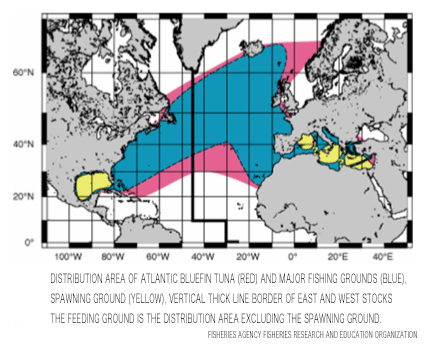
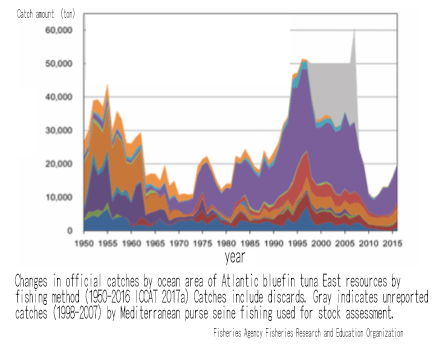
In 2007, the Atlantic Bluefin Tuna Eastern Stocks had an official reported catch of 35,000 tons, but the estimated actual catch was 61,000 tons. The bluefin tuna TAC, which was set by ICCAT at the time, was 20,000 to 36,000 tons, which is almost twice as much. Looking at the recovery of bluefin tuna stocks in Japan in recent years, it seems unlikely that something similar will happen.
Handling of small bluefin tuna in the field of retail
By the way, this month's issue was originally intended to describe the commercialization of small bluefin tuna as usual, but as the small bluefin tuna is writing about things related to the difficult environment in Japan at present, this fish will be used in Japan not only the fisheries industry, but also the interests of the fisheries industries around the world are closely related, and when I refer to the issues related to them, I will be getting deeper and deeper, and It was greatly come off from the original themeI had planned in advance.
What has been described up to this point is definitely about small bluefin tuna, but the theme has largely deviated from the story that included not only Japan but also the circumstances of the world, and the text has become so long. From now on, even if I touch the technical issues such as the commercialization of the small bluefin tuna, the reader's interest seems to be already flying in a different direction, and I would like quit to refer the contents of such technical aspects in this issue.
I want to write at the end of this month's issue. It will be difficult to deal with small bluefin tuna in the future of fish retailing, so I hope that readers do not get caught up in a nuisance.
It is basically unthinkable that the market will crash in the future as small bluefin tuna on the regular route become rich fishing as before. So the trading price will always be high and stable, but on the other hand, there may be cheap small bluefin tuna sale from somewhere on the non-regular route, and there is a possibility that will be bought at a price so low that they can not be compared with the genuine ones.
For example, glass eels still seems to have the movement of the dark route even in recent years when the country strictly manages it. So, even with small bluefin tuna, at this time a gap between ideal and reality is being caused by the TAC, there is always a movement to make a profit behind it. And it has also been repeated in the past that an unforeseen incident from such an environment has occurred.
Even in the retail field, there are always those who look from such a bad direction, and those who become prey are "people who have an idea to pursue immediate profit rather than the ideal idea that should be" .
hose who are trusted by customers and who build on long-lived businesses do not keep up with immediate profits, but consider the future of the future and make the right decisions on what to do. Readers should also make a correct judgment on what should be a business person in such a major environmental change.
| Please access the following URL if you want to secure using SSL. All pages in the site will be secure pages. |
| https://secure02.blue.shared-server.net/www.fish-food.co.jp/message english 4.2019.html |
An opinion and the communication are to iinfo@fish food times
Date of updating 1 Apr. 2019

